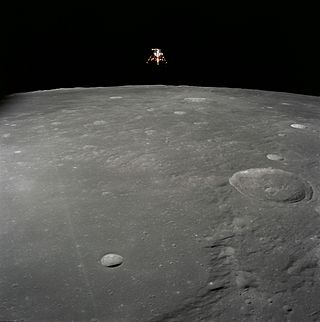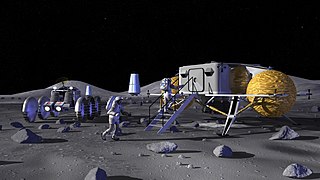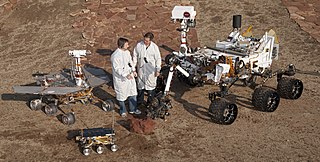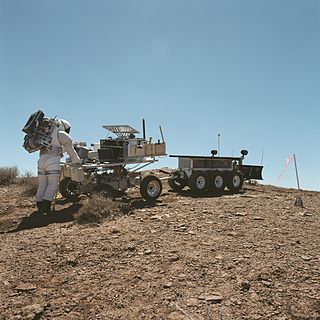
The Lunar Roving Vehicle (LRV) is a battery-powered four-wheeled rover used on the Moon in the last three missions of the American Apollo program during 1971 and 1972. It is popularly called the Moon buggy, a play on the term "dune buggy".

LOK Luna 17 was an uncrewed space mission of the Luna program, also called Lunik 17. It deployed the first robotic rover onto the surface of the Moon.
The Centennial Challenges are NASA space competition inducement prize contests for non-government-funded technological achievements by American teams.

The U.S. Space & Rocket Center in Huntsville, Alabama is a museum operated by the government of Alabama, showcasing rockets, achievements, and artifacts of the U.S. space program. Sometimes billed as "Earth's largest space museum", astronaut Owen Garriott described the place as, "a great way to learn about space in a town that has embraced the space program from the very beginning."
The International Space Development Conference (ISDC) is the annual conference of the National Space Society (NSS). Now in its 41st year, these conferences connect the general public and the NSS membership with leaders of contemporary space efforts. The ISDC provides a nexus for industry, government, scientists, advocates, and the public to meet and discuss the latest issues in space technology, science, policy, commerce, medicine, exploration, settlement and much more. Winners of the annual NASA space settlement Contest annually attend the conference, with several interesting activities and programs. With National Space Society's major goal being to accelerate the process of space exploration and development they also foster astronautics for students by encouraging them and getting them involved.

The physical exploration of the Moon began when Luna 2, a space probe launched by the Soviet Union, made an impact on the surface of the Moon on September 14, 1959. Prior to that the only available means of exploration had been observation from Earth. The invention of the optical telescope brought about the first leap in the quality of lunar observations. Galileo Galilei is generally credited as the first person to use a telescope for astronomical purposes; having made his own telescope in 1609, the mountains and craters on the lunar surface were among his first observations using it.
This is a timeline of space exploration which includes notable achievements, first accomplishments and milestones in humanity's exploration of outer space.

NASA proposed several concept moonbases for achieving a permanent presence of humans on the Moon since the late 1950s. Research and exploration of the Moon has been a large focus of the organization since the Apollo program. NASA's peak budget was in 1964-1965, when it comprised 4% of all federal spending in service of the Apollo Moon landing project. Though lunar landings ever since the conclusion of the Apollo program in 1972 have ceased, interest in establishing a permanent habitation on the lunar surface or beyond low Earth orbit has remained steady. Recently, renewed interest in lunar landing has led to increased funding and project planning. NASA requested an increase in the 2020 budget of $1.6 billion, in order to make another crewed mission to the Moon under the Artemis program by 2025, followed by a sustained presence on the Moon by 2028. A crew was selected for the planned crewed mission, Artemis II, in April of 2023.
A space competition is an inducement prize contest offering a prize to be given to the first competitor who demonstrates a space vehicle, or a space exploration apparatus, which meets a set of pre-established criteria. It spurs pioneering development in private spaceflight.

A rover is a planetary surface exploration device designed to move over the rough surface of a planet or other planetary mass celestial bodies. Some rovers have been designed as land vehicles to transport members of a human spaceflight crew; others have been partially or fully autonomous robots. Rovers are typically created to land on another planet via a lander-style spacecraft, tasked to collect information about the terrain, and to take crust samples such as dust, soil, rocks, and even liquids. They are essential tools in space exploration.

NASA's Desert Research and Technology Studies is a group of teams which perform an annual series of field trials seeking to demonstrate and test candidate technologies and systems for human exploration of the surface of the Moon, Mars, or other rocky bodies.

Astrobotic Technology is an American private company that is developing space robotics technology for lunar and planetary missions. It was founded in 2007 by Carnegie Mellon professor Red Whittaker and his associates with the goal of winning the Google Lunar X Prize. The company is based in Pittsburgh, Pennsylvania. Their first launch occurred on January 8, 2024, carrying the company's Peregrine lunar lander on board the first flight of the Vulcan Centaur Rocket from Florida's Space Force Station LC-41. On June 11, 2020, Astrobotic received a second contract for the Commercial Lunar Payload Services program. NASA will pay Astrobotic US$199.5 million to take the VIPER rover to the Moon, targeting a landing in November 2024.

The Lunar Reconnaissance Orbiter (LRO) is a NASA robotic spacecraft currently orbiting the Moon in an eccentric polar mapping orbit. Data collected by LRO have been described as essential for planning NASA's future human and robotic missions to the Moon. Its detailed mapping program is identifying safe landing sites, locating potential resources on the Moon, characterizing the radiation environment, and demonstrating new technologies.

Aleksandr Leonovich Kemurdzhian was Russian engineer of Armenian descent in the former Soviet space program who worked at the VNIITransmash institute for the most of the second half of the 20th century. He is best known for designing the metal chases for Lunokhod 1— the first ever planetary rover for space exploration in the Soviet space program.

The Space Exploration Vehicle (SEV) is a modular vehicle concept developed by NASA from 2008 to 2015. It would have consisted of a pressurized cabin that could be mated either with a wheeled chassis to form a rover for planetary surface exploration or to a flying platform for open space missions such as servicing satellites and missions to near-Earth asteroids. The concept evolved from the Lunar Electric Rover (LER) concept, which in turn was a development of the Small Pressurized Rover (SPR) concept.

A lunar rover or Moon rover is a space exploration vehicle designed to move across the surface of the Moon. The Apollo Program's Lunar Roving Vehicle was driven on the Moon by members of three American crews, Apollo 15, 16, and 17. Other rovers have been partially or fully autonomous robots, such as the Soviet Union's Lunokhods, Chinese Yutus, and the Indian Pragyan. Four countries have had operating rovers on the Moon: the Soviet Union, the United States, China and India.
The Rocket City Space Pioneers (RCSP) was one of 29 teams from 17 different countries officially registered and in the competition for the Google Lunar X PRIZE (GLXP) during 2010–2012.

Barbara Cohen is a planetary scientist at NASA's Goddard Space Flight Center. The asteroid 6816 Barbcohen is named after her.

The Artemis program is a Moon exploration program that is led by the United States' NASA and formally established in 2017 via Space Policy Directive 1. The Artemis program is intended to reestablish a human presence on the Moon for the first time since Apollo 17 in 1972. The program's stated long-term goal is to establish a permanent base on the Moon to facilitate human missions to Mars.

The Lunar Terrain Vehicle (LTV) is an unpressurized rover being developed by NASA that astronauts can drive on the Moon while wearing their spacesuits. The development of the LTV is a part of NASA's Artemis Program which involves returning astronauts to the Moon, specifically the lunar south pole, by 2025, but the LTV will not fly until Artemis V in 2029 at the earliest. The LTV will be the first crewed lunar rover developed by NASA since the Lunar Roving Vehicle used during the Apollo program.





















